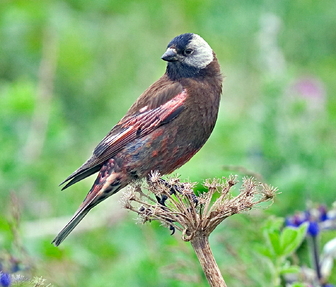Gray-crowned Rosy-Finch
Adults are brown on the back and breast and mainly pink on the rest of the underparts and the wings. The forehead and throat are black; the back of the head is grey. They have short black legs and a long forked tail. There is some variability in the amount of grey on the head.

Author: Alan D. Wilson
The Gray-crowned Rosy-Finch is classified as Least Concern. Does not qualify for a more at risk category. Widespread and abundant taxa are included in this category.
Gray-crowned Rosy-Finches may breed at the highest altitude of any breeding bird in North America. Their typical breeding habitat is rocky talus and snowfields near sedge and grassy areas. They often breed near moist seeps, and are always associated with rocks. In winter they inhabit open lowland areas, including canyons, wheat fields, and grasslands. More
Gray-crowned Rosy-Finch - Leucosticte tephrocotis * Gray-crowned Rosy-finch * Gray-crowned Rosy-Finch Species of Concern Global Rank: G5 State Rank: S2B,S5N Agency Status USFWS: none USFS: none BLM: none FWP Conservation Tier: 2 PIF: none Listen to an Audio Sample More
Gray-crowned rosy-finches are sometimes found in large flocks of over 1,000 individuals, though the flocks that come to my yard are never so big. Some years a flock with only 50 birds visits. But for some reason the number last winter was a record 500-plus birds. To make counts, I photograph the flock in a tree, then count the birds in the picture. If we have a few warm days in winter, the flock vanishes, only to reappear when snow or cold returns. More
The Gray-crowned Rosy-Finch is a medium-sized bird which was once considered to be the same species as the Asian Rosy Finch. This species breeds on rocky islands and open spaces on mountains. They range from Alaska to the northwestern United States. Nests are built in a cup shape, and are on the ground or cliff. Usually, the Gray-crowned Rosy-Finch is a permanent resident of some islands and the Canadian Rockies. Some populations migrate during winter months to the western United States. More
A songbird of extreme environments, the Gray-crowned Rosy-Finch is found in open ground at the top of mountains from Alaska to California and out on the Aleutian and Pribilof islands. More
Species: Gray-crowned Rosy-Finch Leucosticte tephrocotis Subspecies: brown-cheeked tephrocotis (“Gray-crowned Rosy-Finch”) Subspecies: gray-cheeked littoralis (“Hepburn’s Rosy-Finch,” “Gray-headed Rosy-Finch”) The Black Rosy-Finch L. atrata and the Brown-capped Rosy-Finch L. australis are relatively southern in their breeding distributions, summering in the Great Basin and in Colorado and New Mexico, respectively. The two races of Gray-crowned Rosy-Finch L. More
Bent Life History for the Gray-crowned Rosy-Finch - the common name and sub-species reflect the nomenclature in use at the time the description was written. PRIBILOF ROSY FINCH LEUCOSTICTE TEPHROCOTIS UMBRINA Murie HABITS Olaus J. Murie (1944) has given the above name to the rosy finches that breed on the Pribiof Islands and St. Matthew and Otter islands in the Bering Sea, which formerly bore the same name as the birds breeding on the Aleutian Islands. More
The Gray-crowned Rosy-Finch is a medium-large finch, somewhat geographically variable in appearance. Most birds have dark, reddish-brown upperparts and underparts, with gray heads, black foreheads, and pinkish to reddish wing coverts. Sexes similar, though males are brighter in color. Gray-crowned Rosy-finch Female - Sexes similar, though females are duller in color. More
The Gray-crowned Rosy-Finch is the species most likely to be confused with other rosy-finches. Black Rosy-Finch lacks brown back and breast. Brown-capped lacks gray on head. The amount of gray on the head is variable. Young birds may be especially difficult to separate from Brown-capped in the field. More
The Gray-crowned Rosy-Finch is found farther to the west than the similar Brown-capped Rosy-Finch and Black Rosy-Finch. The ancestors of the rosy-finches came from Asia. The mosaic distribution of forms in the West may result from the splitting of one population during glacial periods, or from multiple invasions from Asia. Attracting Finches Visit Shaw Creek Bird Supply to see our selection of Finch Feeders. More

Original source: Caleb Slemmons
-Caleb Slemmons -Author: Caleb Slemmons
Permission: Some rights reserved
Family : Fringillidae
Genus : Leucosticte
Species : tephrocotis
Authority : (Swainson, 1832)
